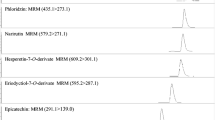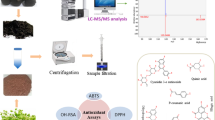Abstract
Peppers are one of the most widely processed and consumed vegetables in the world. The present study was established to obtain phenolic profiles of two fresh and oven-cooked pepper cultivars, red hot Aleppo (Capsicum annuum L.) and red sweet pepper Capia (Capsicum annuum L.). Phenolic extracts of pepper samples have been, for the first time, qualitatively and quantitatively examined by liquid chromatography including tandem mass spectrometry (LC–MS/MS). Apart from the main objective, samples were also examined for their colour alteration regarding the oven cooking process. A total of 20 phenolic compounds were identified and quantified in the red pepper samples. The revealed results showed that the hot Aleppo pepper possessed a much higher phenolic content when compared to Capia peppers. In the Aleppo pepper samples, capsaicin, luteolin 6,8-di-C-hexoside, luteolin O-malonylpentosyldihexoside, luteolin 6-C-hexoside, dihydrocapsaicin, and kaempferol pentosyldihexoside were the most dominant phenolics, while luteolin O-(aposylmalonyl)glucoside, luteolin O-malonylpentosyldihexoside, kaempferol pentosylhexoside, and feruloyl hexoside were for the Capia samples. In the Aleppo samples, capsaicin and dihydrocapsaicin were compounds that significantly increased due to the cooking process. The cooking process not only positively affected the phenolic profile of pepper samples but also the colour, total phenolic content, and antioxidant activity.




Similar content being viewed by others
References
Materska M (2015) Flavone C-glycosides from Capsicum annuum L.: relationships between antioxidant activity and lipophilicity. Eur Food Res Technol 240(3):549–557
Perucka I, Materska M (2001) Phenylalanine ammonia-lyase and antioxidant activities of lipophilic fraction of fresh pepper fruits Capsicum annum L. Innov Food Sci Emerg Technol 2(3):189–192
Reinbach HC, Smeets A, Martinussen T, Møller P, Westerterp-Plantenga MS (2009) Effects of capsaicin, green tea and CH-19 sweet pepper on appetite and energy intake in humans in negative and positive energy balance. Clin Nutr 28(3):260–265
Schweiggert U, Carle R, Schieber A (2006) Characterization of major and minor capsaicinoids and related compounds in chili pods (Capsicum frutescens L.) by high-performance liquid chromatography/atmospheric pressure chemical ionization mass spectrometry. Anal Chim Acta 557(1–2):236–244
Watts G (2014) Food for thought: the expanding universe of cookbook indexing. Indexer 32(4):1–5
Repetto MG, Llesuy SF (2002) Antioxidant properties of natural compounds used in popular medicine for gastric ulcers. Braz J Med Biol Res 35(5):523–534
Usman MG, Rafii MY, Ismail MR, Malek M, Latif MA (2014) Capsaicin and dihydrocapsaicin determination in chili pepper genotypes using ultra-fast liquid chromatography. Molecules 19(5):6474–6488
Hwang IG, Shin YJ, Lee S, Lee J, Yoo SM (2012) Effects of different cooking methods on the antioxidant properties of red pepper (Capsicum annuum L.). Prev Nutr Food Sci 17(4):286
de Jesús Ornelas-Paz J, Martínez-Burrola JM, Ruiz-Cruz S, Santana-Rodríguez V, Ibarra-Junquera V, Olivas GI, Pérez-Martínez JD (2010) Effect of cooking on the capsaicinoids and phenolics contents of Mexican peppers. Food Chem 119(4):1619–1625
Chuah AM, Lee YC, Yamaguchi T, Takamura H, Yin LJ, Matoba T (2008) Effect of cooking on the antioxidant properties of coloured peppers. Food Chem 111(1):20–28
Kelebek H, Kesen S, Selli S (2015) Comparative study of bioactive constituents in Turkish olive oils by LC-ESI/MS/MS. Int J Food Prop 18(10):2231–2245
Ough CS, Amerine MA (1988) Phenolic compounds. Methods for analysis of musts and wines. Wiley, New York
Prabakaran S, Ramu L, Veerappan S, Pemiah B, Kannappan N (2017) Effect of different solvents on volatile and non-volatile constituents of red bell pepper (Capsicum annuum L.) and their in vitro antioxidant activity. J Food Meas Charact 11(4):1531–1541
Sonmezdag AS, Kesen S, Amanpour A, Guclu G, Kelebek H, Selli S (2019) LC-DAD-ESI-MS/MS and GC-MS profiling of phenolic and aroma compounds of high oleic sunflower oil during deep-fat frying. J Food Process Pres 43(3):e13879
Kelebek H, Selli S, Kola O (2017) Quantitative determination of phenolic compounds using LC-DAD-ESI-MS/MS in cv. Ayvalik olive oils as affected by harvest time. J Food Meas Charact 11(1):226–235
Keser D, Guclu G, Kelebek H, Keskin M, Soysal Y, Sekerli YE, Arslan A, Selli S (2020) Characterization of aroma and phenolic composition of carrot (Daucus carota ‘Nantes’) powders obtained from intermittent microwave drying using GC–MS and LC–MS/MS. Food Bioprod Process 119:350–359
Palermo M, Pellegrini N, Fogliano V (2014) The effect of cooking on the phytochemical content of vegetables. J Sci Food Agric 94(6):1057–1070
Daood HG, Kapitány J, Biacs P, Albrecht K (2006) Drying temperature, endogenous antioxidants and capsaicinoids affect carotenoid stability in paprika (red pepper spice). J Sci Food Agric 86(14):2450–2457
Turkmen N, Sari F, Velioglu YS (2005) The effect of cooking methods on total phenolics and antioxidant activity of selected green vegetables. Food Chem 93(4):713–718
Florkiewicz A, Socha R, Filipiak-Florkiewicz A, Topolska K (2019) Sous-vide technique as an alternative to traditional cooking methods in the context of antioxidant properties of Brassica vegetables. J Sci Food Agric 99(1):173–182
Vega-Gálvez A, Di Scala K, Rodríguez K, Lemus-Mondaca R, Miranda M, López J, Perez-Won M (2009) Effect of air-drying temperature on physico-chemical properties, antioxidant capacity, colour and total phenolic content of red pepper (Capsicum annuum, L. var. Hungarian). Food Chem 117(4):647–653
Lee Y, Howard L (1999) Firmness and phytochemical losses in pasteurized yellow banana peppers (Capsicum annuum) as affected by calcium chloride and storage. J Agric Food Chem 47(2):700–703
Jeong WY, Jin JS, Cho YA, Lee JH, Park S, Jeong SW, Kim YH, Lim CS, El-Aty AMA, Kim GS, Lee SJ, Shim JH, Lee SJ (2011) Determination of polyphenols in three Capsicum annuum L. (bell pepper) varieties using high-performance liquid chromatography-tandem mass spectrometry: their contribution to overall antioxidant and anticancer activity. J Sep Sci 34(21):2967–2974
Materska M, Piacente S, Stochmal A, Pizza C, Oleszek W, Perucka I (2003) Isolation and structure elucidation of flavonoid and phenolic acid glycosides from pericarp of hot pepper fruit Capsicum annuum L. Phytochemistry 63(8):893–898
Marín A, Ferreres F, Tomás-Barberán FA, Gil MI (2004) Characterization and quantitation of antioxidant constituents of sweet pepper (Capsicum annuum L). J Agric Food Chem 52(12):3861–3869
Materska M, Perucka I (2005) Antioxidant activity of the main phenolic compounds isolated from hot pepper fruit (Capsicum annuum L.). J Agric Food Chem 53(5):1750–1756
Acknowledgements
We wish to thank Dr. Diana Mary Reichenbach from Adana Alparslan Turkes Science and Technology University-Turkey for their outstanding editing and proof reading.
Author information
Authors and Affiliations
Corresponding author
Ethics declarations
Conflict of interest
The authors declare that they have no conflict of interest.
Compliance with ethics requirements
This article does not contain any studies with human or animal subjects.
Additional information
Publisher's Note
Springer Nature remains neutral with regard to jurisdictional claims in published maps and institutional affiliations.
Rights and permissions
About this article
Cite this article
Kelebek, H., Sevindik, O., Uzlasir, T. et al. LC-DAD/ESI MS/MS characterization of fresh and cooked Capia and Aleppo red peppers (Capsicum annuum L.) phenolic profiles. Eur Food Res Technol 246, 1971–1980 (2020). https://doi.org/10.1007/s00217-020-03548-2
Received:
Revised:
Accepted:
Published:
Issue Date:
DOI: https://doi.org/10.1007/s00217-020-03548-2




